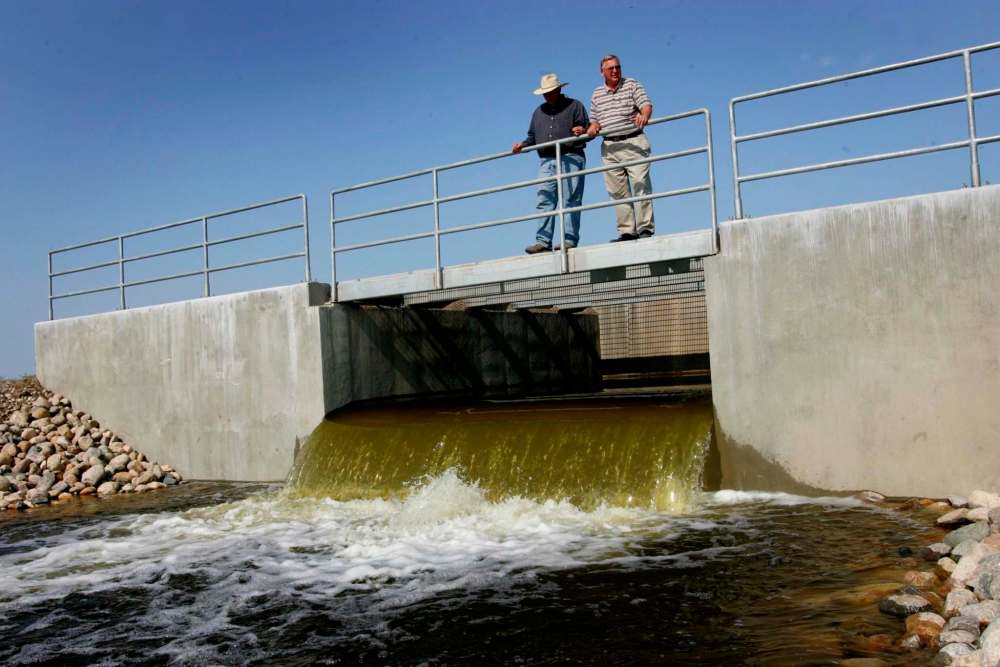NDP worried about impact of American water-diversion projects
Advertisement
Read this article for free:
or
Already have an account? Log in here »
To continue reading, please subscribe:
Monthly Digital Subscription
$0 for the first 4 weeks*
- Enjoy unlimited reading on winnipegfreepress.com
- Read the E-Edition, our digital replica newspaper
- Access News Break, our award-winning app
- Play interactive puzzles
*No charge for 4 weeks then price increases to the regular rate of $19.00 plus GST every four weeks. Offer available to new and qualified returning subscribers only. Cancel any time.
Monthly Digital Subscription
$4.75/week*
- Enjoy unlimited reading on winnipegfreepress.com
- Read the E-Edition, our digital replica newspaper
- Access News Break, our award-winning app
- Play interactive puzzles
*Billed as $19 plus GST every four weeks. Cancel any time.
To continue reading, please subscribe:
Add Free Press access to your Brandon Sun subscription for only an additional
$1 for the first 4 weeks*
*Your next subscription payment will increase by $1.00 and you will be charged $16.99 plus GST for four weeks. After four weeks, your payment will increase to $23.99 plus GST every four weeks.
Read unlimited articles for free today:
or
Already have an account? Log in here »
Hey there, time traveller!
This article was published 16/08/2017 (3031 days ago), so information in it may no longer be current.
With two major North Dakota-based water diversion projects nearing development, NDP environment critic Rob Altemeyer is urging the provincial and federal governments to ensure the incoming flow won’t damage Manitoban waters.
The Northwest Area Water Supply would carry water from the Missouri River to northwestern North Dakota, where it would then enter the Assiniboine River system. The Red River Valley Water Supply project would divert water to the state’s northeastern region, then flow into the Red.
While the diversions are intended to stabilize regional water supplies in case of drought, Altemeyer, the MLA for Wolseley, believes they can have dangerous consequences on the water systems involved.

He pointed to a diversion from Devils Lake into the Red River carrying low-quality water with a high rate of dissolved solids as an example of problems the projects could cause.
Altemeyer worries the introduction of new water to the Red and Assiniboine rivers could boost phosphorus and nitrogen levels, which, if left unchecked, could cause algal blooms in connected lakes.
And because the rivers belong to the Hudson Bay water basin, which has been separated from the Missouri River basin for thousands of years, potentially harmful foreign species can be introduced to local waters and throw the entire system off, Altemeyer said.
“It happened with zebra mussels,” he said.
Duane DeKrey, general manager for the Garrison Diversion Conservancy District, a political subdivision of the North Dakota state government, called Altemeyer’s concerns “unfounded.”
A U.S. court ruled the water from the Northwest Area project was sufficiently treated for the project to progress, DeKrey said, noting the water from the Missouri was of a much higher quality than Devils Lake.
In order for the projects to proceed, Altemeyer wants the provincial and federal governments to take extensive precautions to prevent such ecological disturbances.
The North Dakota government must demonstrate the incoming water contains no harmful foreign species before the diversions begin, but even then, the effects of mixing separated water sources are difficult to accurately predict, he said.
As part of the Red River project, three options for treatment funded by North Dakota are on the table. The cheapest treatment option is a US$23-million sand and silt removal; the median option is a $54-million clarification, chlorination and dichlorination method; and the most expensive — and extensive — option would cost $233 million.
Altemeyer contends even the high-end choice wouldn’t sufficiently treat the water, but DeKrey called that fear unfounded as well.

The provincial government has been too quiet about the potential impact of the projects and has done little to inform the public of what’s going on, Altemeyer said.
“It’s the province’s job to be monitoring this. As far as I can tell, there’s been no communication with the public, and that is not acceptable,” he said.
In a statement made early in August, Cathy Cox, the provincial minister of sustainable development, said the potential environmental impacts of the projects haven’t been overlooked.
“Manitoba’s primary concern with the Northwest Area Water Supply Project and inter-basin water transfers in North Dakota has always been the serious ecological consequences that would result from the introduction of harmful invasive species and aquatic diseases from the Missouri River Basin into Manitoba’s rivers and lakes,” Cox said.
Construction on the Red River project will hopefully begin in spring 2019, DeKrey said.
North Dakota is predicted to suffer a major drought by 2050, and this project, which could stabilize water supplies for up to 260,000 people on either side of the Red, is one that must begin before it’s too late, he said.
ben.waldman@freepress.mb.ca

Ben Waldman is a National Newspaper Award-nominated reporter on the Arts & Life desk at the Free Press. Born and raised in Winnipeg, Ben completed three internships with the Free Press while earning his degree at Ryerson University’s (now Toronto Metropolitan University’s) School of Journalism before joining the newsroom full-time in 2019. Read more about Ben.
Every piece of reporting Ben produces is reviewed by an editing team before it is posted online or published in print — part of the Free Press‘s tradition, since 1872, of producing reliable independent journalism. Read more about Free Press’s history and mandate, and learn how our newsroom operates.
Our newsroom depends on a growing audience of readers to power our journalism. If you are not a paid reader, please consider becoming a subscriber.
Our newsroom depends on its audience of readers to power our journalism. Thank you for your support.


